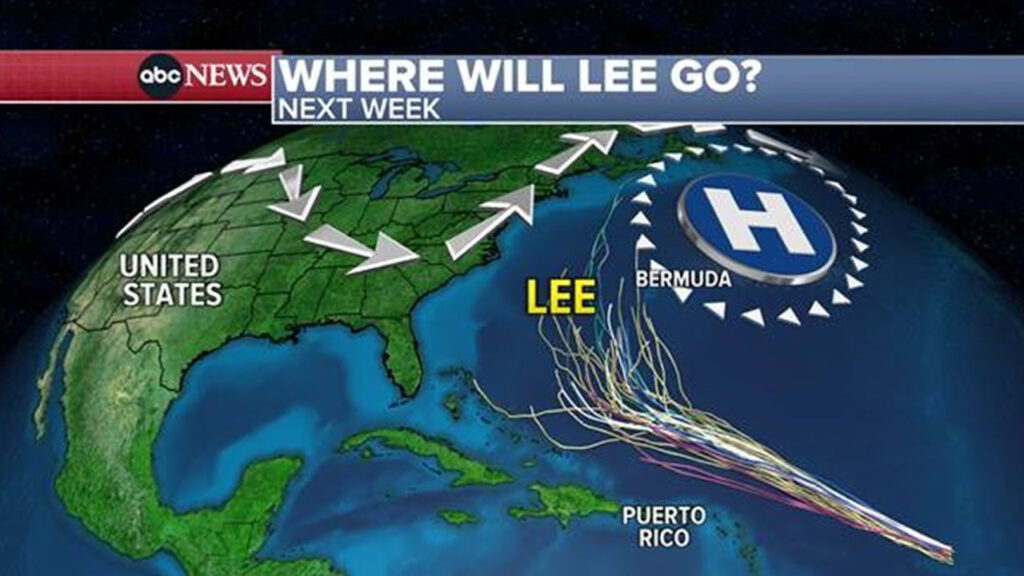As Hurricane Lee intensifies in the Atlantic, its trajectory towards New England has become a subject of concern and intense study. This article delves into the pivotal spaghetti models in predicting the hurricane’s path. It provides an in-depth look at how these models work, their accuracy, and what the predictions mean for New England residents.

Understanding Spaghetti Models in Hurricane Forecasting
The Basics of Spaghetti Models
Spaghetti models, a colloquial term in meteorology, are essentially an ensemble of predictions from various computer models that forecast the path of a hurricane. These models are named for their resemblance to strands of spaghetti on a map, each representing a different potential path the storm could take. These paths are plotted based on various factors, including atmospheric pressure, temperature, humidity, wind speeds, and historical weather patterns.
The Role of Spaghetti Models in Predicting Hurricane Lee’s Path
In the case of Hurricane Lee, meteorologists are closely analyzing these spaghetti models to predict its trajectory. Each model offers a different projection based on its unique algorithm and data input. The convergence of these paths gives forecasters a better idea of the most likely route the hurricane will take. However, it’s important to note that while these models are useful, they are not infallible. The inherent unpredictability of weather systems, especially those as complex as hurricanes, means there is always a degree of uncertainty.
The Science Behind Forecasting Hurricanes
How Meteorologists Predict Hurricanes
Meteorologists use various tools and data to predict the path of hurricanes. Satellite imagery, weather balloons, radar, and aircraft reconnaissance contribute valuable data. This data is then fed into various computer models, each designed to analyze different aspects of the storm and the environment it is moving through.
Advances in Hurricane Forecasting Technology
Over the years, hurricane forecasting has significantly improved due to technological advances. High-resolution satellite imagery and more sophisticated computer models have increased the accuracy of predictions. Additionally, the advent of supercomputers has allowed for processing vast amounts of data at unprecedented speeds, further refining the accuracy of hurricane tracking and intensity forecasts.

Hurricane Lee’s Predicted Impact on New England
Current Projections for Hurricane Lee
The latest spaghetti models suggest various paths as Hurricane Lee barrels towards New England. While some models predict a direct hit, others suggest a near miss with the hurricane veering off into the Atlantic. However, the expectation of strong winds, heavy rain, and potential coastal flooding in parts of New England is consistent across models.
Preparing for the Worst: What New England Should Expect
Residents in New England should prepare for the worst while hoping for the best. This means securing property, stocking up on emergency supplies, and staying informed about the latest advisories and evacuation orders if necessary. The potential impact of hurricane Lee spaghetti models includes power outages, disrupted transportation, and flooding, especially in low-lying areas.
The Accuracy and Limitations of Spaghetti Models
How Accurate Are Spaghetti Models?
While spaghetti models are essential in hurricane forecasting, their accuracy is not absolute. The farther out the forecast, the greater the uncertainty. This is due to the chaotic nature of weather systems and many variables that can affect a hurricane’s path. Generally, the accuracy of these models is higher when predicting the path 3-5 days in advance.
Understanding the Limitations
The public and decision-makers must understand the limitations of these models. They should not be viewed as precise predictions but rather as a range of possible outcomes. This understanding helps prepare for various scenarios and avoids relying on a single predicted path.
The Role of Climate Change in Intensifying Hurricanes
Climate Change and Its Impact on Hurricanes
Research has shown that climate change is playing a role in intensifying hurricanes. Warmer ocean temperatures contribute to more powerful and wetter storms. In the case of Hurricane Lee, while it’s difficult to attribute its strength solely to climate change, warmer ocean temperatures have likely contributed to its intensity.

Future Projections and Concerns
As the planet continues to warm, the intensity and frequency of powerful hurricanes like Lee are expected to increase. This presents a growing challenge for meteorologists and disaster preparedness authorities. More accurate forecasting and effective response strategies are becoming increasingly crucial in this changing climate landscape.
Conclusion: Navigating the Uncertainty of Hurricane Lee
As Hurricane Lee approaches New England, residents and authorities must navigate the uncertainty of its path and potential impact. Spaghetti models provide a valuable tool in this process, offering a range of scenarios that aid in preparation and response planning. However, it’s crucial to approach these models with an understanding of their limitations and the role of broader environmental factors, such as climate change, in shaping these powerful storms.


